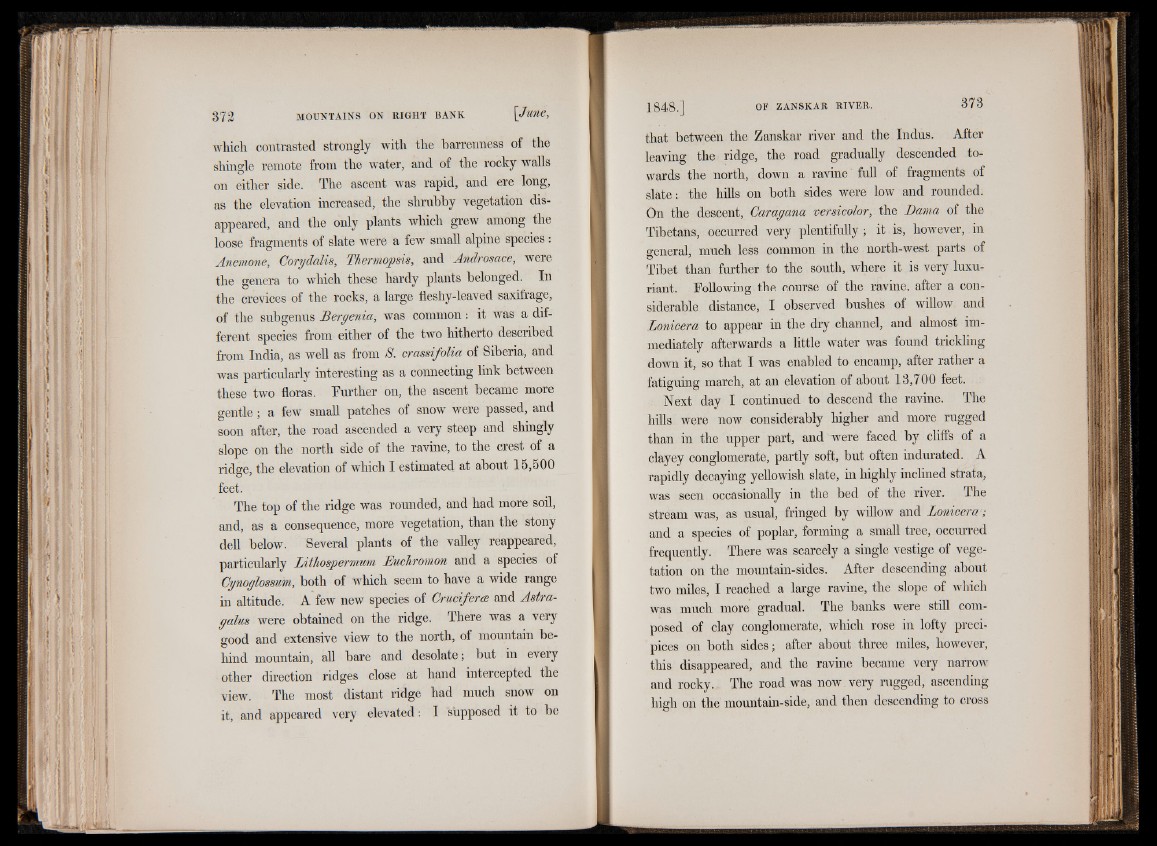
which contrasted strongly with the barrenness of the
shingle remote from the water, and of the rocky walls
on either side. The ascent was rapid, and ere long,
as the elevation increased, the shrubby vegetation disappeared,
and the only plants which grew among the
loose fragments of slate were a few small alpine species :
Anemone, CorydaJis, Thermopsis, and Androsace, were
the genera to which these hardy plants belonged. In
the crevices of the rocks, a large fleshy-leaved saxifrage,
of the subgenus Bergenia, was common: it was a different
species from either of the two hitherto described
from India, as well as from 8. crassifolia of Siberia, and
was particularly interesting as a connecting link between
these two floras. Further on, the ascent became more
gentle; a few small patches of snow were passed, and
soon after, the road ascended a very steep and shingly
slope on the north side of the ravine, to the crest of a
ridge, the elevation of which I estimated at about 15,500
feet.
The top of the ridge was rounded, and had more soil,
and, as a consequence, more vegetation, than the stony
dell below. Several plants of the valley reappeared,
particularly Lithospermurn Euchromon and a species of
Cynoglossum, both of which seem to have a wide range
in altitude. A few new species of Crucifercb and Astragalus
were obtained on the ridge. There was a very
good and extensive view to the north, of mountain behind
mountain, all bare and desolate; but in every
other direction ridges close at hand intercepted the
view. The most distant ridge had much snow on
it, and appeared very elevated: I supposed it to be
that between the Zanskar river and the Indus. After
leaving the ridge, the road gradually descended towards
the north, down a ravine full of fragments of
slate; the hills on both sides were low and rounded.
On the descent, Caragana versicolor, the Bama of the
Tibetans, occurred very plentifully; it is, however, in
general, much less common o ' in the north-west parts of
Tibet than further to the south, where it is very luxuriant.
Following the course of the ravine, after a considerable
distance, I observed bushes of willow and
Lonicera to appear in the dry channel, and almost immediately
afterwards a little water was found trickling
down it, so that I was enabled to encamp, after rather a
fatiguing march, at an elevation of about 13,700 feet.
Next day I continued to descend the ravine. The
hills were now considerably higher and more rugged
than in the upper part, and were faced by cliffs of a
clayey conglomerate, partly soft, but often indurated. A
rapidly decaying yellowish slate, in highly inclined strata,
was seen occasionally in the bed of the river. The
stream was, as usual, fringed by willow and Lonicera;
and a species of poplar, forming a small tree, occurred
frequently. There was scarcely a single vestige of vegetation
on the mountain-sides. After descending about
two miles, I reached a large ravine, the slope of which
was much more gradual. The banks were still composed
of clay conglomerate, which rose in lofty precipices
on both sides; after about three miles, however,
this disappeared, and the ravine became very narrow
and rocky. The road was now. very rugged, ascending
high on the mountain-side, and then descending to cross